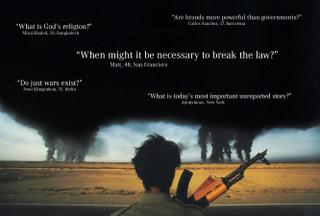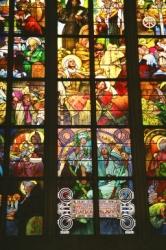Wednesday, August 10, 2005
Reverse Osmosis
In less than 12 hrs..
I was feeling fatherish (if that is a word) a couple of days after July 18th and then it dissapeared - only to reappear now, as I am preparing for my trip. Guess it will truly sink in when I hold her in my arms.
I will be in Chennai till the 15th of Sept and then spend a few days in Mumbai before heading back home (yes, Trondheim is home now!!!) on the 18th.
Friday, August 05, 2005
What is you question?
 Yes, what is your question to the collective wisdom of the world?
Yes, what is your question to the collective wisdom of the world?Dropping Knowledge gives you this chance.
Dropping Knowledge describes itself as an eductaional resource that connects people around the globe seeking to exchange ideas and solutions to the most pressing questions of our day.
On their website they say
dropping knowlege means dropping the assumption that we know all the answers. It means questioning the conventional wisdom. It means figuring out which questions are the most important to ask, sharing answers and then challenging those answers. We call the proctice of asking questions and sharing wisdom, dropping knowledge.
599 questions have been asked thus far. All these questions (and many more yet to be asked) will be combined to form a social issue framework. A pool of 1000 potential participants will form a web-based source of research, which will be used to narrow the answers by 112 global leaders. An audio-visual interactive archive online will be built for these answers that will encourage a global discussion.
The scale of the projec is very impressive. Wether it will succeed or not in its ultimate goal of generating wisdom...well, as always, only time will tell.
Go on, ask your question.
Link via WorldChanging.
Thursday, August 04, 2005
Earlier Marxists - now Jihadis
In his book "Globalized Islam," the French scholar Olivier Roy points out that today's jihadists have a lot in common with the left-wing extremists of the 1930's and 1960's. Ideologically, Islamic neofundamentalism occupies the same militant space that was once occupied by Marxism. It draws the same sorts of recruits (educated second-generation immigrants, for example), uses some of the same symbols and vilifies some of the same enemies (imperialism and capitalism).
Roy emphasizes that the jihadists are the products of globalization, and its enemies. They are detached from any specific country or culture, he says, and take up jihad because it attaches them to something. They are generally not politically active before they take up jihad. They are looking to strike a vague blow against the system and so give their lives (and deaths) shape and meaning.
This view is quite interesting and contrary to my view - posted as a comment to Sunil Laxman's post on the same topic.
Seemingly random events

The image above has no fixed pattern (particularly on the right side), and each pixel seems to be unrelated to the next. If each pixel were taken to be an event, the image would represent a collection of events, or more pertinently, a seemingly random collection of events.
Erik Fosnes Hansen in his book Tales of Protection, writes that seemingly disparate and unconnected events in life are connected by a profound something - a something that has not been found or recognized as yet.
The image shown here is a Cellular Automaton of 500 steps from Stephen Wolfram's A New Kind of Science (You can find an earlier post on this here). The image is produced starting with a single black pixel and each subsequent pixel is colored according to Rule 30 in the book. Thus, the seemingly random collection of pixels (or events) is produced using a simple program (Rule 30) and is the something, in this case.
Wolfram, in the introduction to the book, boldly states that this new science, an intellectual revolution, can be used to explain everything. I have only ploughed through 168 pages of this 1197 pages book. Based on what I have read thus far, it is very exciting.
Is this the key to understanding the connection between seemingly disconnected events - such as the probability case?
Wednesday, August 03, 2005
And now probability
In Tales of Protection, Erik Fosnes Hansen bases his fiction on how a collection of seemingly random events are connected by a pattern. As an example:
The probability of heads or tails occurring when a coin is tossed is 0.5. If we get heads 9 times in a row, one would think that there is a greater chance of getting tails the next toss. Yet, the probability is still only 0.5 of getting heads (or tails). Over a large number of tosses, the heads and tails will even out according to its probability. This is fundamental in figuring probability and is call the Law of Large Numbers.
The paradox is that one toss of a coin is unrelated to the next, yet over a large number of tosses the number of heads attain an equilibrium value ( = 0.5 x number of tosses). How is this possible? If the two of us were tossing coins in different parts of the world, would heads turning up for me be affected by what you get?
Is this a self-referencing paradox related to the Gödel's Incompletenesss Theorem? On second thoughts, we probably should leave this much abused theorem be.
Statistics as anecdotal thinking...
Statistics is to engineers, like lamp-posts are to drunks - they are used more for support than for illumination.This got me thinking - where is statistics used for illumination? Before we proceed it would be worthwhile checking the definition of statistics given here.
Census, I feel, is a practical branch of statistics mainly because its sample is the entire population. Analyzing the census data could illuminate what already exists, but when one tries to use this data for prediction, it is no longer practical. Similar is the case with polls. How scientific are scientifically conducted polls?
Michael Schemer, differentiating between anecdotal thinking (that leads to superstition) and science in his column Skeptic in The Scientific American May 05 issue says:
What we havehere is a signal-to-noise problem. Humans evolved brains that are pattern-recognition machines, adept at detecting signals that enhance or threaten survival amid a very noisy world. This capability is association learning - associating the causal connections between A and B - as when our ancestors associated the seasons with the migration of game animals.
Unfortunately, the system has flaws. Superstitions are false associations - A appears connected to B, but it is not (the baseball player who doesn't shave and hits a home run). Las Vegas was built on associated learning.
..... - if you scan enough noise, you will eventually find a signal, whether it is there or not.
.....
We evolved as a social primate species whose language ability facilitated the exchange of such association anecdotes. The problem is that although true pattern recognition helps us survive, false pattern recognition does not get us killed, so the overall phenomenon has endured the winnowing process of natural selection. .... Anecdotal thinking comes naturally; science requires training.
The key from the piece above is - if you scan enough noise, you will eventually find a signal, whether it is there or not. This is similar to the fact that any set of data can be fitted to a polynomial equation - I vaguely remember reading that the figure of an elephant can be fitted with a polynomial equation. But what value does this equation have in predicting the next data point?
Statistics is a form of pattern recognition, or rather a method for pattern recognition. If used without the right set of data, it becomes nothing more than anecdotal thinking. Thus statistics are a rigorous method in science is questionable.
Statistics has played, and certainly will play, a huge part in science and engineering - in my area of expertise, thermodynamics, Statistical Thermodynamics is important to answer question Why? rather than How? answered by Classical Thermodynamics. I understand that regression analysis, parameter estimation etc are widely used in science and engineering. But the most important footnote when using any of these methods is their range of applicability - which again depends on the data used.
What I am trying to convey through this muddled post is that unless used within a clear predefined set of constraints or bounds, the use of statistics is equivalent to anecdotal thinking and is divorced from science.

